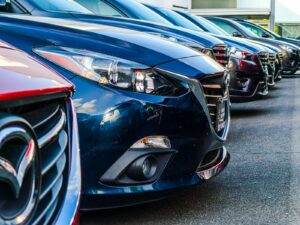How Do Car Dealerships Work Behind the Scenes?

Car dealerships are well-presented buildings with shiny floors and smiling salespeople. They have operated largely unchanged for decades.
But how do they actually work? When you order a brand-new car from a dealer on finance, what transaction or transactions have taken place in the background?
Most UK consumers have no idea how car dealerships work; therefore, this article will hopefully reveal some interesting truths about this profitable industry.
A car dealer may not be who they appear to be
Some people make the mistake of assuming that when they buy a Jaguar from a Jaguar dealership that they’re buying directly from the manufacturer. This is usually incorrect. Car dealerships are independent businesses that are owned by people.
The two businesses are separate to allow each to focus on their core skill (i.e., what they are good at).
Car manufacturers focus on designing, building, and creating a brand image for a vehicle. Car dealerships focus on displaying their stock to the public and closing the deal.
Car dealerships are 3-4 businesses in one
Many will assume that a dealership makes most of its money from selling cars. While this will certainly be the case from the perspective of how much cash each activity will bring in, it’s quite possible that it earns more profit from other lines of business.
Customers have a clear idea of the market price for a vehicle and the high-ticket price attached to a car makes it very worthwhile for them to haggle the price down. Due to a need to hit volume targets set by manufacturers; dealers will often be happy to let a vehicle go for only a slim margin above their purchase price.
Dealerships earn fixed commissions for selling financial services products such as car insurance and car finance packages. These can result in payments exceeding £1,000 to the dealer. Considering that many consumers will plan to acquire their luxury saloons via a hire purchase or personal contract purchase plans, and do not negotiate hard on the terms of the finance deal, it’s easy to see why these are profitable to arrange.
Companies need to earn this margin to cover their costs, such as housing a large team and importantly; arranging for temporary car insurance to allow exciting test drives to take place.
Car dealers operate on thin ice
Branded car dealers can use the manufacturer’s logo because they have signed an agreement (called either a license or franchise agreement) with the manufacturer which usually grants them exclusive rights to sell new vehicles from the supplier in a geographical region.
Therefore, you won’t find two Mercedes dealerships competing from opposite sides of the same road. Manufacturers carve up the UK into territories that will each house a single dealership.
This effectively grants a local monopoly to the licensee, which makes the proposition to sell vehicles on behalf of the manufacturer more attractive.
The downside for the dealer is that these licenses are granted only for a fixed period at a time. If the manufacturer is unhappy with the performance of the dealer, they may choose to serve notice and pick a different company to engage with. Without a license, a franchised dealer will be unable to afford the expensive fixtures and fittings of the existing dealership and may have little choice but to sell the site to the incoming dealer.
In summary
A car dealer is usually a private company that operates at arm’s length from the manufacturer they represent. Tough volume targets set by the manufacturer through a dealer franchise agreement encourage the sale of vehicles at a low margin. This encourages the dealers to make profits from ancillary services such as insurance products, vehicle finance and serving to generate a suitable level of profit to cover the risk they take.






